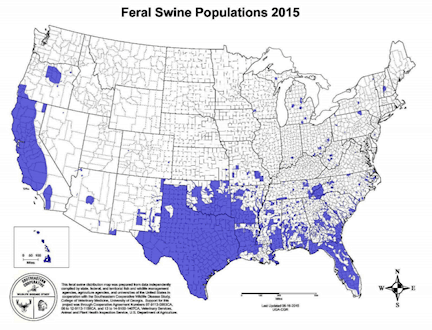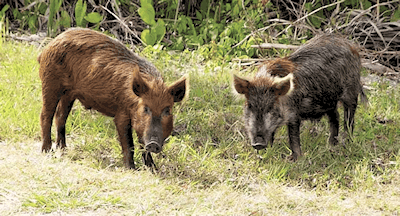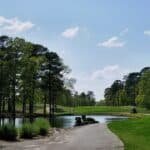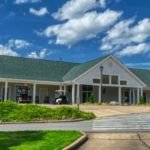Invasive feral hogs have been sighted in the Village.
Feral hogs are one of the one hundred worst invasive species in the world today (Lowe et al. 2000). The feral hog population has grown rapidly in the United States and has become a huge problem in many states including Arkansas.
According to the Arkansas Game and Fish Commission, “Feral hogs are not native to the United States. They are an invasive species, a public nuisance and a threat to Arkansas. ” Mar 15, 2018

Jim Langford emails board about feral hogs in the Village
Jim Langford sent the following email to the Board Directors and Village Voice concerning this disturbing issue:
“I have not seen a CWAO “Chief Wild Animal Officer” listed in the CEO’s Organization Chart so I am sending this to you, our Board of Directors. We have wild feral hogs in the Village. Full-grown hogs have been seen in several places in the Village and piglets have been seen on Ponce de Leon near the fire station.”
“If this problem is not addressed immediately we will have a destructive problem on our hands. There is only one way to rid an area of feral hogs. They have to be killed. If this problem is not addressed quickly we could have several hundred hogs in the Village in two years. Feral hogs will destroy our golf courses, our lake dams, and homeowners’ property. I trust you will address this problem immediately.” – Jim Langford
Feral hogs are prolific
Farm Journal/ AG Web reports: according to State officials, they “estimate there are roughly 200,000 fast-breeding feral hogs spread across the state’s 75 counties.”
Feral hogs are prolific, reaching sexual maturity as young as three (3) months to one year. The estrus cycle of the female occurs every 18 to 24 days if the female is not pregnant. She is capable of birthing from one (1) to twelve (12) newborns, with an average of four (4) to six (6) piglets. A pregnancy can last from 100 to 140 days. As the female ages, the possibility of larger litters increases until she reaches the age of four (4) to five (5), at which time her litter size may decrease. A sow generally has two litters a year and the oldest known age of a breeding female is 14.
The damage from feral hogs can be great
Feral hogs can potentially cause many problems in the Village. Some possible damages are:
- Rooting – this is the most commonly noticed damage caused by feral hogs.
- Tree and forest losses – one hog can destroy 400 to 1000 tree seedlings in one day. They also chew on the roots and rub against more mature trees, causing damage.
- Disease – feral hogs are known to carry at least 30 viral and bacterial diseases, which may affect humans, livestock and wildlife.
- Preying on other animals.
- Wallowing – this affects streams and can contaminate water holes, create algae blooms, and decrease fish production.
- Property damage – this includes damage to sprinkler systems and also automobiles when there are collisions
Where are feral hogs in Arkansas?*
- “Feral hogs are in every county in Arkansas, though local population densities vary.
- Feral hogs have lived in the bottomlands of south central Arkansas for decades, if not centuries.
- They typically live in secluded areas in thickets near creeks, streams, and rivers, though some venture into urban areas.
- Feral hogs range over several miles if necessary in search of food and water.
- Boars range even farther in search of mates.”
Wild pigs/hogs destroy golf course
While this incident did not happen in Arkansas, this is an example of what wild hogs/pigs can do to a golf course.
We would like to thank Jim Langford for taking the time to write emails to the Board Directors and also the Village Voice. Hopefully, this issue will be addressed and this potentially devastating problem will be dealt with.
By Cheryl Dowden, October 16, 2019
* Where are feral hogs found in Arkansas?
Cover photograph and map courtesy of Southeastern Asociation of Fish & Wildlife Agencies, 2015 Annual State Summary Report — Wild Hog Working Group












Anonymous
10/16/2019 — 3:30 pm
Time for a hog hunt yes with guns ( rifles) and dogs if possible plus put a bounty on them
P Daly
10/16/2019 — 3:34 pm
Send pics of these feral hogs … the hogs spotted by fire station were pot bellied domestics . Jon noblet posted pics on ND , they belong to a person off 5 hwy . We used to have boar many years ago but even in areas outside the gates , they are rarely seen today . We do have feral hogs in areas further out , away from populated areas.
HSVP C
10/16/2019 — 4:28 pm
Paul, feral hogs are an invasive species. If there are pot-bellied pigs running around HSV, they will soon turn into a feral lot. I am not saying the smaller pot-bellied pig would do the same damage as the larger pig; it probably wouldn’t, but it would still turn into a problem, just like feral dogs can.
Feral hogs have been caught in Hot Springs. Why would you think there wouldn’t be any here? https://www.youtube.com/watch?v=YL4Yeg8X40s
“Feral hogs are in every county in Arkansas, though local population densities vary.
Feral hogs have lived in the bottomlands of south central Arkansas for decades, if not centuries.
They typically live in secluded areas in thickets near creeks, streams, and rivers, though some venture into urban areas.
Feral hogs range over several miles if necessary in search of food and water.
Boars range even farther in search of mates.”
Anonymous
10/16/2019 — 5:39 pm
The POA needs to create an Ad Hoc Hog Committee to study the issue. HSV deer hunters should report any hog sightings to animal control. I have seen the damage feral hogs can do on farmland.
Joe
10/17/2019 — 6:25 am
We must kill them all. We need a bow hunt. For the geese, too.
Arnold the Green Acres pig
10/20/2019 — 5:57 pm
We don’t have to worry about feral hogs in Hot Springs Village. Our gates will keep the pigs out, unless they tailgate in!
Mary Ann Kennedy
10/28/2019 — 9:09 am
According to our police department and animal control, the only pigs spotted in HSV were the domestic pot belly pigs, and they were caught.
HSVP C
10/29/2019 — 9:32 am
Thank you for your input, Mary. Did they locate the owners of the pot belly pigs?
Anonymous
10/29/2019 — 8:46 am
No worries everyone! As soon as the pigs start destroying our sacred golf courses or start damaging lake shore properties, then and only then. will the POA and the Board do something about it. Why? Because that’s where most of the “leadership” resides. Until then, start giving names to your piggy four-legged neighbors because they’ll be moving in and starting families abundanza!